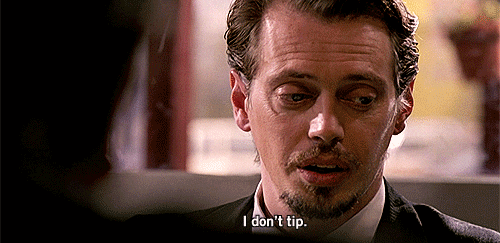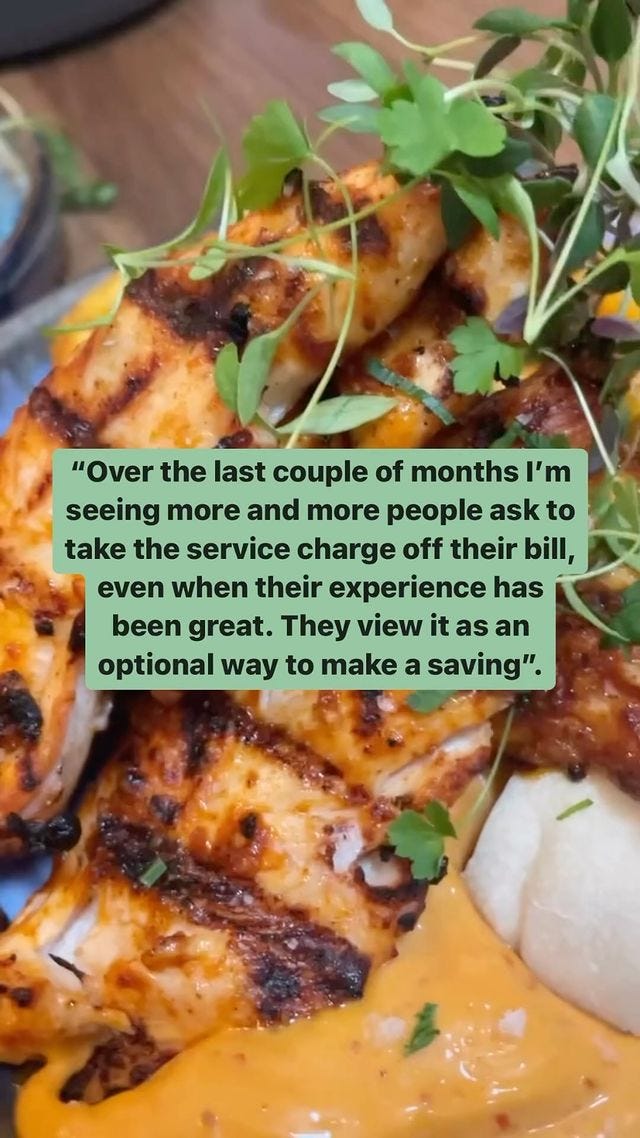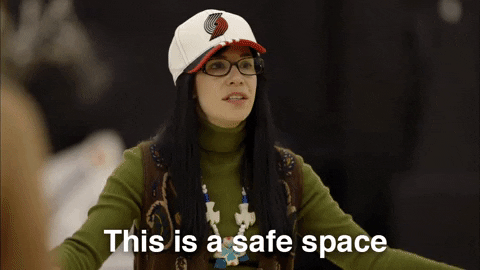Welcome to your free, Monday edition of London in Bits. Today we’re talking about the tricky area of tipping (or the lack of it, anyway), plus we consider the claims made by our new Met Commissioner about how incredibly safe London is right now.
This issue is public so, if you enjoy it, then please feel free to share it or post on social media:
Tipping point
As well as providing a jobs board for the hospitality industry, Countertalk also works to promote healthy work environments and generally improve the industry. So, we can be pretty confident that, when they posted this to their Instagram the other day, it wasn’t just clickbait:
The copy alongside the post reads:
“We’ve heard this one from a few people recently. Have you? At a moment when people are tightening their belts, they often forget that hospitality workers are feeling the pinch too - and that this removal will exacerbate that.”
A few days after they posted that, a Countertalk spokesperson told the Standard:
“We’re hearing this in places with quite high volume. It’s not something happening across the industry, but it’s a warning sign — if it’s going on even in two or three places, it could continue to rise. Our view is that customers are being more difficult generally. They’re going out, but they want to save, probably because their disposable income has gone down.”
The Standard, for their part, spoke to a grand total of two London restaurants to confirm that “they’ve not experienced these problems”. But there’s no denying that there is a trend here, one that is about more than just ‘belt tightening’ and which has been bubbling away since the first lockdown.
It all began with furlough
When they introduced the furlough scheme, the government decided to exclude service charge from their calculations for the hospitality industry. This meant that a lot of people working in bars, restaurants and hotels got way below the promised 80% of their regular monthly wage. According to some of the reports from 2020, 30% of wages could be made up of ‘service charge’, so employees were looking at receiving closer to half of their normal income.
As a result, a number of restaurants started to take away the ‘optional supplementary charge’ completely, incorporating it into the cost of the dishes instead. Broadway Market butcher and wine bar, Hill and Szrok posted to Instagram in July of 2020, saying:
“These weird times have given everyone a chance to pause for thought, to re-evaluate. As we begin to open up the restaurant for our private dinners and get back to normal service, we’re scrapping service charge. There won’t be a discretionary 12.5% included on the bill, there won’t be an option to add a tip when we hand you the card machine, there won’t even be a jar by the till.”
While the owner of the Turkish restaurant Oklava (which, if you read our most recent Weekend Roundup, you’ll know just closed its doors) tweeted around the same time:
“We will no longer be adding the customary optional 12.5% service charge onto our bills. Instead, it will be incorporated into our menu prices. The optional service charge has always gone to our staff, in full.”
As well as being welcomed by those working in hospitality, this trend was a big hit with the kind of person who had always seen the ‘optional’ 12.5% service charge as “pulling the wool over customers’ eyes”. And the whole thing cast a bit of a spotlight on restaurant pricing generally, leading to a series of broadsheet editorials with headlines like Let’s call time on tipping and endless tabloid articles with headlines like Woman sparks debate about tipping after asking for 10% charge to be taken off her bill despite ‘good service’ (yes, that one is the Mail, how did you guess?).
On your bike
One of the other big effects lockdown had on our eating habits was, of course, the massive surge in people using delivery apps. But that also meant there was a huge surge in people realising how much more expensive it was to get their food delivered.
Because apps like Deliveroo and Just Eat charge restaurants fees that are typically around 30% of the price of the order, that cost usually gets passed on to the customer. So, a dish that costs you £10 in the restaurant, might run you closer to £15 via an app. Then you’re paying a delivery fee and a ‘service fee’ on top…
... And only then are you asked if you’d like to tip the driver.
In November of last year, the BBC ran an article with the headline Should you tip the takeaway delivery driver? in which they reported that the average Uber Eats tip had “risen by more than 30% in recent months, while on Deliveroo it doubled from March to September”. Yet the numbers of people tipping the food delivery staff in the UK “still trails behind the US”. One Deliveroo driver in Hemel Hempstead said “only a quarter of people tip him” - in the US, that number was closer to 90%.
Meanwhile, the etiquette expert consulted by the Beeb recommended “starting at 10% for a tip, and adding a little bit more if you can afford it.” but also said that “sharing a kind word or a smile with a driver can be enough, if finances are stretched.”
Over the last year or so, the chances of a delivery driver receiving a ‘warm smile’ instead of cold hard cash has increased massively, as food prices have gone through the roof and the delivery companies have had to start charging even more to compensate for the loss of business caused by the cost of living crisis.
All bar none
In the post-lockdown months, when many pubs had a ‘table service only’ policy, it wasn’t unusual to have an optional service charge added to the bill, even if you’d only ordered drinks (and maybe a scotch egg, so you passed the ‘substantial meal’ test).
But, since the war in Ukraine began pushing grain costs way up - taking the cost of a pint with them - some pubs have retained that practice of adding an optional service charge, even if you’re ordering drinks at the bar.
Cue a series of outraged posts to the r/London subreddit documenting examples of this happening (followed by some lazy rewrites of those posts by MyLondon’s army of ‘trainee reporters’).
Bearing all that in mind, is it any wonder that people in London are, at best, confused about their relationship with tipping? Even in the US (where you’d think they had gratuity down to a fine art), tipping is becoming a minefield. An article popped up in the Atlantic the other day saying that there’s a “pervasive sense of cultural confusion about parts of the practice,” which has “been exacerbated by societal upheaval from the pandemic, mounting cultural and political frustrations, and broken business models.”
At least we’re still tipping cabbies. A recent analysis of 2,000 taxi and minicab drivers found that the average taxi tip is a relatively healthy 10% (or £3.10). However, the study also found that while “passengers are most likely to leave a tip in the evening, between 7pm and midnight” the worst hours for tipping were “recorded between midnight and 5am”. Not sure we can put that down to ‘cultural and political frustrations’.
Coming up on Wednesday 🐟
In our subscriber-only edition this week, we speak to historian and author Charlie Taverner about the history of hawkers and street food in London.
Subscribe to LiB today to make sure you don’t miss out:
Don’t worry, London is ‘fantastically safe’ now
Met Commissioner Mark Rowley must have made some serious new year’s resolutions, because he has been everywhere in the last few days.
He kicked things off in a boxing gym in Ilford (naturally) a couple of Fridays ago, where he declared that London is now a “fantastically safe” city, thanks to a drop in homicide rates in 2022.
And he’s right about the drop in homicides. Home Office figures show that murders went down by 17% compared to 2021 (from 132 to 109). But the whole ‘fantastically safe’ thing is a bit of a stretch considering overall offences were up by 7.6%, and that includes almost 1,500 more sexual offences and 5,000 more robberies.
(Of course, it was almost inevitable that, in the days following Rowley’s announcement, there’d be an incident which would make him wish he’d kept his mouth shut.)
At the same event Rowley admitted that there are “hundreds” of officers in the force that he needs “to sort out and who shouldn’t be in the organisation”. He picked up on this theme again last Thursday when he had to respond to a Guardian investigation which revealed there are 150 officers currently under investigation over allegations of sexual misconduct or racism. Rowley told the paper that “We have some very worrying cases with officers who’ve committed criminality whilst police officers and yet I’m not allowed to sack them…. It’s crazy,” and said that he had been working with the home secretary and the prime minister who “have been very helpful in ordering a review that I hope will change the rules to make it easy to move the toxic people.”
A couple of days before that, Rowley had been at the Institute of Engineering and Technology where the spoke about “a plan” to “turn things around” that he’s been working on for the last four months (a draft version of which we should see very soon).
In the same speech Rowley defended stop and search tactics, claiming they can halve the murder rate, and that he would be “using “better data” to make sure that the measure was directed at the right people.
Rowley is a big advocate of ‘data’. So much so that he’s also promised to “crack down on men who are violent predators”, by building a list of tens of thousands of offenders in order to target “the 100 most dangerous men”. The Met’s history of using intelligence to build databases of dangerous men hasn’t gone all that well in the past, but hopefully they’ve learned a few lessons along the way.
Finally, on Thursday Rowley popped up on Radio 4’s Today programme, where he claimed that Met officers are willing to report on their colleagues for ‘toxic’ behaviour (which seems highly improbably given the current culture in the Met) and expressed worries that some of his officers were having to relying on food banks due to the fact that they’ve seen a real-terms pay cut of 14% over the last decade.
5 little bits
Another Tory has chucked his hat in the ring to go up against Sadiq in next year’s mayoral elections. This time it’s the minister for London, Paul Scully. But, as most people don’t even realise we have a minister for London, Scully’s chances of getting the backing of his party are pretty low, even with the Standard trying to paint him as Sutton’s answer to JFK.
Talking of Tory mayors: Boris Johnson was rumoured to be moving to Dulwich Village once he moved out of Downing Street, but this week The Mirror reported that he was living in a £20m property in Knightsbridge that is “owned by the wife of Tory donor Lord Bamford.”
And talking of Sutton: the borough’s Liberal Democrat council has issued a statement saying they are going to fight the Ulez expansion by refusing to greenlight the installation of the cameras needed to enforce the charge. According to the Telegraph Bromley, Bexley, Hillingdon and Harrow councils have also said that “they are now examining the legality of the extension”.
Do you know what an Elf Bar is? If you’re a student then it’s likely that you’re not just aware of “the strongest available vapes in the UK,” but you’re actually addicted to them as well. Student culture magazine The Tab surveyed “18,000 students from 24 universities nationwide” and found that 40% of students in London have used the vapes (which they claim have “taken over uni campuses”) and a massive “25% say they are addicted” to them.
Brixton Academy isn’t going to reopen anytime soon. The venue’s licence was originally suspended until today, but the Met has said that they’ll be seeking to extend that by another three months at a hearing later today, “in order to allow time to ensure the venue is safe to reopen”.
A quick correction: We messed up a link in Saturday’s roundup. Here is the NY Times’ ‘52 Places to go in 2023’ (with London at number one).
Bonus video: The ‘hyperrealistic’ robot of Yayoi Kusama that’s currently painting dots on the window of Harrods.






